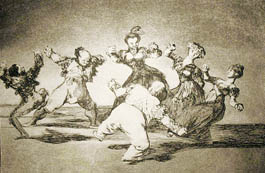home | metro silicon valley index | the arts | visual arts | review

Courtesy of Landau Traveling Exhibitions, L.A., CA
Dance Fever: In Plate 12 of Goya's 'Los Proverbios,' a woman must pay the piper for pleasure.
Profane Masters
New shows of Goya and Picasso etchings at S.J. Museum of Art expose human foibles and lust
By Richard von Busack
THE NEW double exhibition at the San Jose Museum of Art, containing work by a pair of cantankerous old Spaniards, is the perfect introduction to art for those who have avoided museums. Many never go on the sensible grounds that they dread high-mindedness, obscurity and the pretty-pretty. This terrific pair (suitable for all except little children), "Picasso: Etchings of Love & Desire" mated with "Goya's Caprichos: Dreams of Reason and Madness," would make a memorable first-time experience for people who have never entered a museum. (I would also recommend Goya's "Disasters of War" show, now at the Berkeley Art Museum.)
Francisco Goya y Lucientes and Pablo Picasso; one was master, one was pupil. In these shows, the former is superior and the latter is inferior. Goya's Caprichos, done at age 53, demonstrate the artist's pioneering use of aquatint and etching to chart what he called the "innumerable foibles and follies to be found in any civilized society." The show also contains some prime examples from two other print series by Goya: Los Desastres de la Guerra and Los Proverbios. (The medium is well described in cantankerous old would-be Spaniard Robert Hughes' essential biography, Goya.)
On the whole, the images themselves are as accessible as editorial cartoons. In a combination of spidery line and ominous black clouds, Goya depicted some 80 instances of human idiocy, summed up in a few terse words of Spanish underneath every image. Commentary on the labels helps identify the context and the obscure imagery. The interpretations have the suggestive yet cryptic significance of Tarot card explanations.
In the Caprichos No. 19–21, Goya depicts humans as Diogenesian featherless bipeds. "All Will Fall" is the caption on No. 19, where a lovely harpy is luring a group of bald-headed male birds. In No. 20, on the ground, they are plucked and fucked and driven away with brooms. In No. 21, it is now cat-men judges who have their way with the female lure: "How they pluck her!" Goya laments in his caption, and the cycle is complete.
As bleak comedy, these Caprichos succeed wonderfully. The museum makes the show more accessible with Podcast commentary and a drawing table where one can add one's own caprice (n., goat-dance) to the display. Masterpieces can be funny, and like cartoons, they can contain funny animals; take the proud donkey admiring his genealogical chart ("Asta su abuelo": "His Granddad was one, also.") Observe the parrot croaking a sermon from a pulpit to rapt worshippers ("What a golden beak!").
Like all cynical laughter, it dies early. Goya's fancy turns to monsters: No. 50, "The Chinchillas" contains mad square-headed creatures reputed to influence the look of Karloff's Frankenstein. In No. 58, "Swallow It, Dog," a monk wields an enema gun, literally forcing his doctrine up a victim's ass. If he had a sick horror of prostitution, Goya loved women; observe the voluptuously bellied nude witch in No. 68 being taken for her learner's permit ride on a broom.
Thus one goes to the other half of the museum to see Picasso's etchings, on a subject of universal appeal. The old man in his late 70s contemplates what he has always loved, the bodies of women: the curves, the curly-haired keyhole, the simple asterisk of the anus. Here are giantesses so large as to dwarf the artists peering at them; in one etching, an old man's eyes bulge larger than the breasts he's staring at. (A caricature of Degas shows the artist so overwhelmed by his subject, he doesn't know whether to paint or flee.) On a blank wall, the museum loops a projection of Clouzot's The Mystery of Picasso to show the old man at work; another wall bears one of his mottos, "When it is chaste, it is not art." There's nothing vulgar in these shows, and yet they are suffused with the world's ancient wisdom: The former suggests that people are jackasses. The latter suggests that sex is the only thing that makes life bearable.
GOYA'S CAPRICHOS and PICASSO: ETCHINGS OF LOVE AND DESIRE run through April 20 at the San Jose Museum of Art, 110 S. Market St., San Jose. (408.271.6840)
Send a letter to the editor about this story.
|
|
|
|
|
|